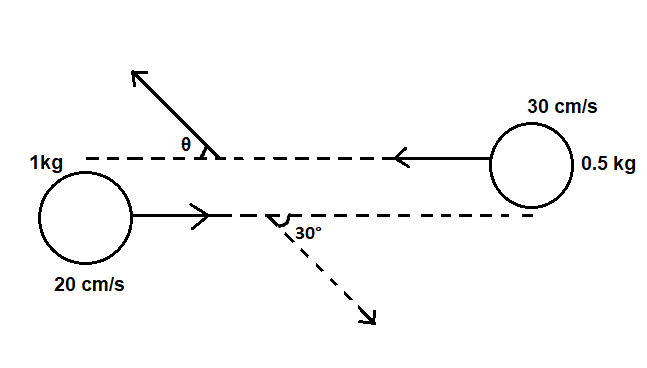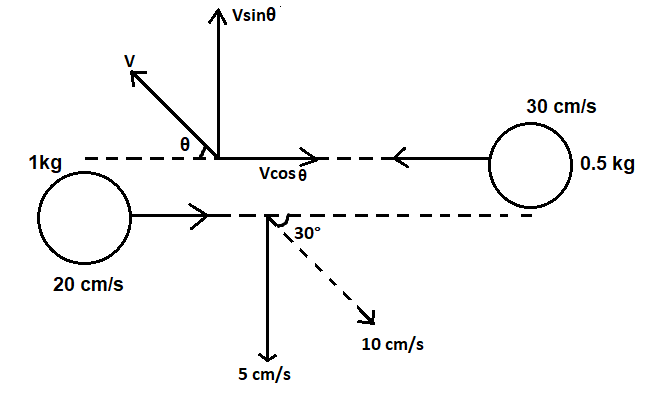
Two balls collide bounce off each other as shown in the figure. The \[1kg\] ball has a speed $10cm/s$ after collision. The velocity of the $0.5kg$ ball will be

(A) $36cm/s$
(B) $24cm/s$
(C) $12.4cm/s$
(D) $18cm/s$
Answer
143.1k+ views
Hint According to Newton’s second law of motion, the rate of change of momentum of a body is directly proportional to the applied force and the change takes place in the direction of the force. We know that the momentum of a body is equal to the product of mass and velocity. So if we calculate the momentum we can find the velocity from that.
Formula used:
$P = mv$ (Where $P$ stands for the momentum of the object, $m$stands for the mass of the object, and $v$ stands for the velocity of the particle.)
Complete Step by step solution

The figure given above shows how we can resolve the velocity vector into its components.
After the collision, the $1kg$ball will have a velocity $10cm/s$
The angle between the velocity vector and the path of the ball is given as, ${30^ \circ }$
From this, we can find the sin component of the velocity vector of$1kg$the ball as,
$v\sin \theta = 10\sin {30^ \circ } = 5cm/s$
Let us take the velocity of the $0.5kg$as $v$ and the sin and cos components of the velocity vector are $v\sin \theta $and $v\cos \theta $respectively.
According to the principle of conservation of linear momentum,
The momentum along the $y$direction will be,
${P_i} = {P_f} = 0$…………………………………………………………………(1)
Where ${P_i}$ is the initial momentum and ${P_f}$is the final momentum
We know that the momentum of a body is,
$P = mv$
Substituting the values of mass and the component of velocity in $y$direction in the equation (1)
$1 \times 5 = \left( {0.5} \right)v\sin \theta = 0$
From this equation, we can write
$5 - \left( {0.5} \right)v\sin \theta = 0$
We can write
$v\sin \theta = \dfrac{5}{{0.5}} = 10cm/s$
From this, we get that
$v\sin \theta = 10cm/s$…………………………………………………………………………………..(2)
The momentum of the body in $x$-direction is,
${P_i} = {P_f}$
i.e.
${m_1}{u_1} + {m_2}{u_2} = {m_1}{v_1}\cos \theta + {m_2}{v_2}\cos \theta $………………………………………………………..(3)
It is given that,
${m_1} = 1kg$
${u_1} = 20cm/s$
${m_2} = 0.5kg$
${u_2} = 30cm/s$
${v_1}\cos \theta = 10\cos {30^ \circ } = 10\dfrac{{\sqrt 3 }}{2} = 5\sqrt 3 $
We have to find the value of ${v_2}$from equation (3)
Substituting the values in equation (2), we get
$1 \times 20 - 0.5 \times 30 = 1 \times 5\sqrt 3 - 0.5 \times {v_2}\cos \theta $
Calculating,
$20 - 15 = 5\sqrt 3 - 0.5v\cos \theta $
$5\sqrt 3 - 5 = 0.5v\cos \theta $
From this we get
$v\cos \theta = \dfrac{{5(\sqrt 3 - 1)}}{{0.5}} = 10\left( {\sqrt 3 - 1} \right)$
We can write
$v\cos \theta = 10\left( {\sqrt 3 - 1} \right)$………………………………………………………………….(4)
Squaring and add equation (2) and (4)
${v^2}{\sin ^2}\theta + {v^2}{\cos ^2}\theta = {10^2} + {\left( {10\left( {\sqrt 3 - 1} \right)} \right)^2}$
This can be written as,
${v^2}({\sin ^2}\theta + {\cos ^2}\theta ) = {10^2}\left( {1 + 3 + 1 - 2\sqrt 3 } \right)$
${v^2} = {10^2}\left( {5 - 2\sqrt 3 } \right)$ $\left( {\because {{\sin }^2}\theta + {{\cos }^2}\theta = 1} \right)$
We can get the velocity by taking the square root of the above equation,
$v = 10\sqrt {5 - 2\sqrt 3 } $
This will be,
$v = 10\sqrt {1.5358} $
i.e.
$v = 12.4cm/s$
The answer is:Option (C): $12.4cm/s$
Note
In all collisions the total linear momentum is conserved. But the kinetic energy of the system need not be conserved. The collision in which the total kinetic energy is conserved is called an elastic collision. If the total kinetic energy of a system is not conserved after collision then it is called an inelastic collision.
Formula used:
$P = mv$ (Where $P$ stands for the momentum of the object, $m$stands for the mass of the object, and $v$ stands for the velocity of the particle.)
Complete Step by step solution

The figure given above shows how we can resolve the velocity vector into its components.
After the collision, the $1kg$ball will have a velocity $10cm/s$
The angle between the velocity vector and the path of the ball is given as, ${30^ \circ }$
From this, we can find the sin component of the velocity vector of$1kg$the ball as,
$v\sin \theta = 10\sin {30^ \circ } = 5cm/s$
Let us take the velocity of the $0.5kg$as $v$ and the sin and cos components of the velocity vector are $v\sin \theta $and $v\cos \theta $respectively.
According to the principle of conservation of linear momentum,
The momentum along the $y$direction will be,
${P_i} = {P_f} = 0$…………………………………………………………………(1)
Where ${P_i}$ is the initial momentum and ${P_f}$is the final momentum
We know that the momentum of a body is,
$P = mv$
Substituting the values of mass and the component of velocity in $y$direction in the equation (1)
$1 \times 5 = \left( {0.5} \right)v\sin \theta = 0$
From this equation, we can write
$5 - \left( {0.5} \right)v\sin \theta = 0$
We can write
$v\sin \theta = \dfrac{5}{{0.5}} = 10cm/s$
From this, we get that
$v\sin \theta = 10cm/s$…………………………………………………………………………………..(2)
The momentum of the body in $x$-direction is,
${P_i} = {P_f}$
i.e.
${m_1}{u_1} + {m_2}{u_2} = {m_1}{v_1}\cos \theta + {m_2}{v_2}\cos \theta $………………………………………………………..(3)
It is given that,
${m_1} = 1kg$
${u_1} = 20cm/s$
${m_2} = 0.5kg$
${u_2} = 30cm/s$
${v_1}\cos \theta = 10\cos {30^ \circ } = 10\dfrac{{\sqrt 3 }}{2} = 5\sqrt 3 $
We have to find the value of ${v_2}$from equation (3)
Substituting the values in equation (2), we get
$1 \times 20 - 0.5 \times 30 = 1 \times 5\sqrt 3 - 0.5 \times {v_2}\cos \theta $
Calculating,
$20 - 15 = 5\sqrt 3 - 0.5v\cos \theta $
$5\sqrt 3 - 5 = 0.5v\cos \theta $
From this we get
$v\cos \theta = \dfrac{{5(\sqrt 3 - 1)}}{{0.5}} = 10\left( {\sqrt 3 - 1} \right)$
We can write
$v\cos \theta = 10\left( {\sqrt 3 - 1} \right)$………………………………………………………………….(4)
Squaring and add equation (2) and (4)
${v^2}{\sin ^2}\theta + {v^2}{\cos ^2}\theta = {10^2} + {\left( {10\left( {\sqrt 3 - 1} \right)} \right)^2}$
This can be written as,
${v^2}({\sin ^2}\theta + {\cos ^2}\theta ) = {10^2}\left( {1 + 3 + 1 - 2\sqrt 3 } \right)$
${v^2} = {10^2}\left( {5 - 2\sqrt 3 } \right)$ $\left( {\because {{\sin }^2}\theta + {{\cos }^2}\theta = 1} \right)$
We can get the velocity by taking the square root of the above equation,
$v = 10\sqrt {5 - 2\sqrt 3 } $
This will be,
$v = 10\sqrt {1.5358} $
i.e.
$v = 12.4cm/s$
The answer is:Option (C): $12.4cm/s$
Note
In all collisions the total linear momentum is conserved. But the kinetic energy of the system need not be conserved. The collision in which the total kinetic energy is conserved is called an elastic collision. If the total kinetic energy of a system is not conserved after collision then it is called an inelastic collision.
Recently Updated Pages
How to find Oxidation Number - Important Concepts for JEE

How Electromagnetic Waves are Formed - Important Concepts for JEE

Electrical Resistance - Important Concepts and Tips for JEE

Average Atomic Mass - Important Concepts and Tips for JEE

Chemical Equation - Important Concepts and Tips for JEE

Concept of CP and CV of Gas - Important Concepts and Tips for JEE

Trending doubts
JEE Main 2025 Session 2: Application Form (Out), Exam Dates (Released), Eligibility, & More

JEE Main Exam Marking Scheme: Detailed Breakdown of Marks and Negative Marking

JEE Main 2025: Derivation of Equation of Trajectory in Physics

Electric Field Due to Uniformly Charged Ring for JEE Main 2025 - Formula and Derivation

Degree of Dissociation and Its Formula With Solved Example for JEE

Physics Average Value and RMS Value JEE Main 2025

Other Pages
Units and Measurements Class 11 Notes: CBSE Physics Chapter 1

JEE Advanced Marks vs Ranks 2025: Understanding Category-wise Qualifying Marks and Previous Year Cut-offs

NCERT Solutions for Class 11 Physics Chapter 1 Units and Measurements

JEE Advanced 2025: Dates, Registration, Syllabus, Eligibility Criteria and More

Motion in a Straight Line Class 11 Notes: CBSE Physics Chapter 2

JEE Advanced Weightage 2025 Chapter-Wise for Physics, Maths and Chemistry




